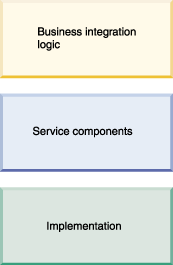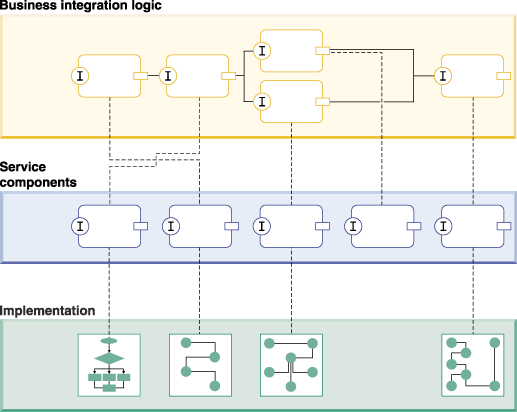IBM BPM, V8.0.1, All platforms > Authoring services in Integration Designer > Get started with IBM Integration Designer
Service-oriented architecture
Service-oriented architecture (SOA) is a loosely-defined industry standard that presents all business processes in a service-oriented way. Dependencies among services such as web services, Enterprise Information System (EIS) service assets, workflows, and databases are minimized and implementation of any service is hidden.
The goal of service-oriented architecture is to separate business integration logic from implementation so that an integration developer can focus on assembling an integrated application rather than on the implementation details. To achieve that end, service components that contain the implementation of individual services required by business processes are created. The result is an architecture of three layers (business integration logic, service components, and implementation) as shown in the following diagram:

Because the service components contain the implementation, they can be assembled graphically by the integration developer without the knowledge of implementation details. Service components also provide the option of letting the integration developer, or someone who works for the integration developer, add the implementation later. Components are assembled together visually. In other words, you are not exposed to the code within the components. In the business logic level shown in the diagram that follows, the components are assembled independently of their implementation. The service oriented architecture, then, lets you focus on solving your business problems by using and reusing components rather than diverting your attention to the technology that is implementing the services you are using.

Key benefits of service-oriented architecture
With the increased rate of modern business, a service-oriented architecture provides the agility to react to and capitalize on changing business conditions. It also offers to make your software sustainable over time. It achieves these goals through the following means:
- Consolidating business logic and business data. Components used by various groups in a corporation or even shared among a set of corporations can be used by everyone as the components comply to industry standards like the Web Services Descriptive Language (WSDL) and the Business Process Execution Language (BPEL), which are independent of platform and vendor. Data is consistently represented in the same way, allowing data to be shared among components of a service-oriented architecture application.
- Leveraging applications and systems that already exist. When you place applications and systems inside WSDL code, they become universally available to any application developer in the enterprise developing a current application.
What are the fundamental design issues of a service oriented architecture?
- Components are loosely coupled. A component accessing another component does not require knowledge of the data structures, the calls to other components, transaction management, and so on in that other component.
- Components are configurable. Looking at a service oriented architecture application such as the previous diagram is similar to looking at a configuration diagram. Components can be added, deleted, and configured in different ways to create new applications.
- Components are interoperable. Any one component can interoperate with another component including components created by different vendors' development environments.
- Components are location independent.
Together, these design principles create a flexible architecture able to adapt to and thrive on rapidly changing business conditions.
Get started with IBM Integration Designer
Related concepts:
SCA
Deployment options for IBM Integration Designer
The runtime environments for IBM Integration Designer
Task flows
Related information:
Team development in IBM BPM